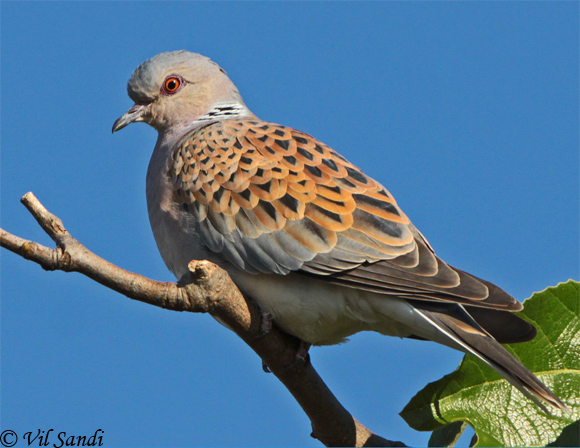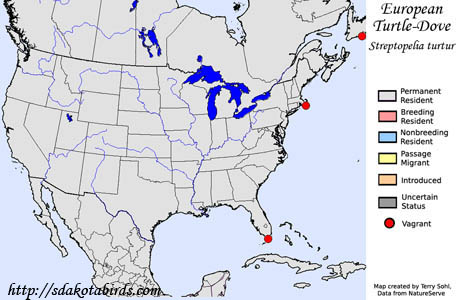| Length: 10-11 inches | Wingspan: 18-22 inches | Seasonality: Non-resident in South Dakota |
| ID Keys: Grayish overall with back and wings coverts of chestnut and black, white and black striping on nape, black tail with white edge | ||
 The
European Turtle Dove is normally found throughout most of Europe, eastward
through far western China. The species had been an extremely rare
vagrant to Iceland, but starting in the 1960s, sightings there began to
increase. Along with other dove and pigeon species, they've shown a
tendency to sometimes wander long distances, yet when individual birds were
found in southern Florida in April of 1990, and in Newfoundland in May
2001, the species' status in North America was still considered uncertain.
European Turtle-Doves are not commonly kept as caged birds, but for these
first two occurrences, it could not be discounted that they represented
escapees from captivity. In July of 2001, another European Turtle-Dove
was found on Nantucket Island in Massachusetts. The bird had been hit by a
vehicle but the body was clearly identifiable as a European Turtle-Dove.
Based on the previous two sightings in the North American region, the fact
that species has been known to sometimes wander far from its normal range,
and the increasing sightings in Iceland, the American Birding Association
officially added European Turtle-Dove to the checklist of North American
birds.
The
European Turtle Dove is normally found throughout most of Europe, eastward
through far western China. The species had been an extremely rare
vagrant to Iceland, but starting in the 1960s, sightings there began to
increase. Along with other dove and pigeon species, they've shown a
tendency to sometimes wander long distances, yet when individual birds were
found in southern Florida in April of 1990, and in Newfoundland in May
2001, the species' status in North America was still considered uncertain.
European Turtle-Doves are not commonly kept as caged birds, but for these
first two occurrences, it could not be discounted that they represented
escapees from captivity. In July of 2001, another European Turtle-Dove
was found on Nantucket Island in Massachusetts. The bird had been hit by a
vehicle but the body was clearly identifiable as a European Turtle-Dove.
Based on the previous two sightings in the North American region, the fact
that species has been known to sometimes wander far from its normal range,
and the increasing sightings in Iceland, the American Birding Association
officially added European Turtle-Dove to the checklist of North American
birds.
Habitat: Found in a variety of semi-open habitats, including agricultural land with scattered hedgerows and brush, open grassy areas with scattered shrubs and trees, and forest and woodland edges and clearings. They avoid unbroken forest or other areas of dense continuous vegetative cover. They are well adapted to a human presence in some areas and can be found in suburban parks and green spaces.
Diet: Feeds heavily on the seeds of grains and weeds, but will also feed on fruits, berries, insects, and small invertebrates such as snails and earthworms.
Behavior: Foraging is primarily done by walking along the ground, picking up food items from the ground or low vegetation.
Nesting: The nest of a European Turtle-Dove is a simple platform of sticks, lined with softer materials such as grasses, leaves, and feathers, usually placed fairly close to the ground in a tree or shrub. The female lays 2 eggs, and both parents help to incubate them. The young hatch after 12-14 days and are fed by both parents until they fledge from the nest at about 20 days old. In many parts of their range, a mating pair will raise two or even three broods each breeding season.
Song: The typical sound of a European Turtle-Dove is a soft monotonic cooing, turrrr-turrrr-turrrrrr.
Migration: Strongly migratory, birds the breed in Europe and Asia migrated to Africa for the winter season.
Interactive eBird map: Click here to access an interactive eBird map of European Turtle-Dove sightings
Similar Species: Similar in overall structure and size to several other pigeon and dove species, but the distinctive plumage makes the European Turtle-Dove easily recognizable if seen well. The only species it would likely to be confused with is the very similar Oriental Turtle-Dove. In North America, both are extremely rare vagrants. However, the European Turtle-Dove has only been seen on the far eastern edge of North America, while the Oriental Turtle-Dove has only been seen on the far western edge. Range can thus be used to help differentiate the two species when they do make their extremely rare appearances in North America.
Conservation Status: European Turtle-Doves are found across an extremely wide area in Eurasia, from far western Europe eastward all the way through western China. However, they have declined precipitously in recent decades. Loss of nesting habitat is undoubtedly one major cause of the decline, partly due to expanded agricultural land use in parts of its range, as well as changes in agricultural management practices such as removal of formerly beneficial hedgerows. Disease may also play a role as they are susceptible to some parasitic infestations. The birds are also heavily hunted in parts of their range. Given the high rate of decline in recent decades and the assessment of continued threats in the future, in 2015 the IUCN upgraded the status of the European Turtle-Dove from a species of "Least Concern" to a species that is now considered "vulnerable".
Further Information: 1) The Royal Society for the Protection of Birds - European Turtle-Dove
2) Birds of Kazakhstan - European Turtle-Dove
3) Oiseaux-birds.com - European Turtle-Dove
Photo Information: Photo by Vil Sandi - licensed under Creative Commons Attribution NoDerivs 2.0 Generic License
| Click below for a higher-resolution map |
 |
| South Dakota Status: Non-resident in South Dakota |
Additional European Turtle-Dove Photos (coming soon!!)
